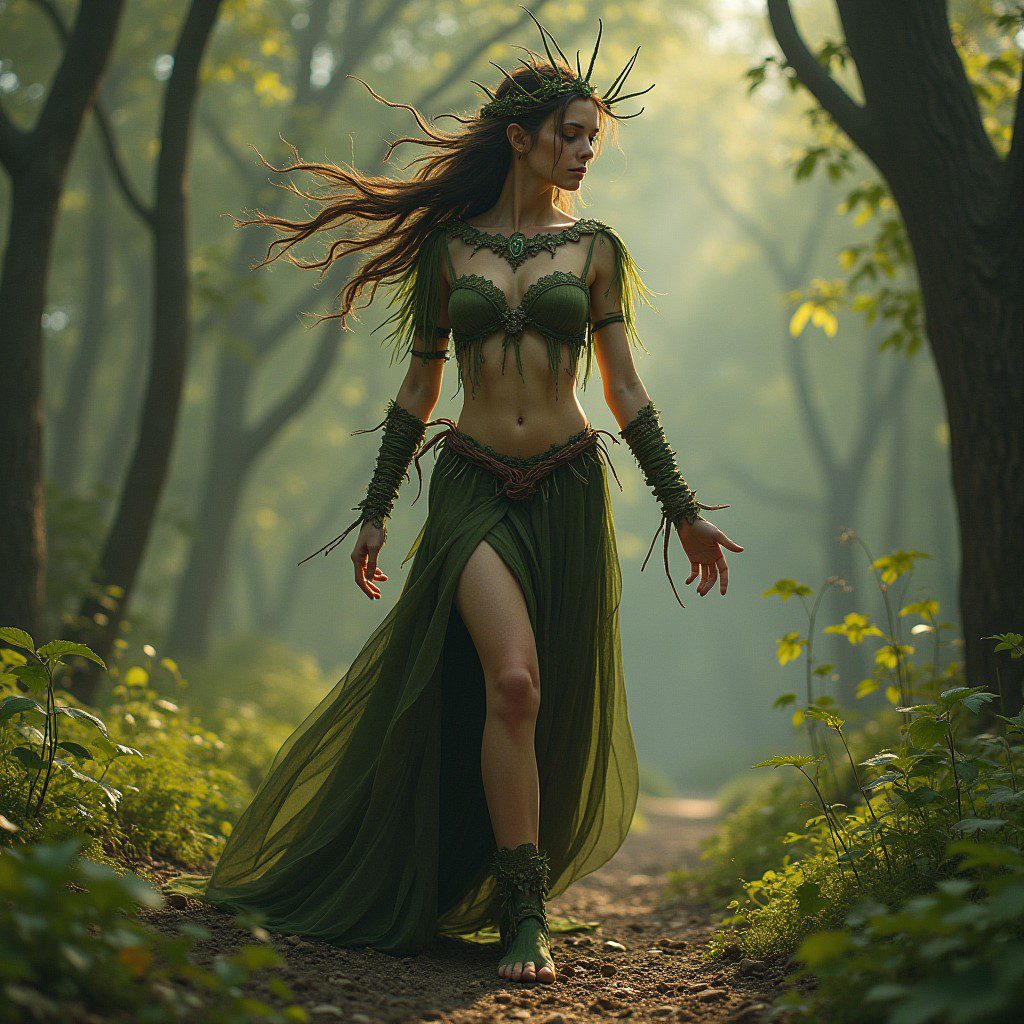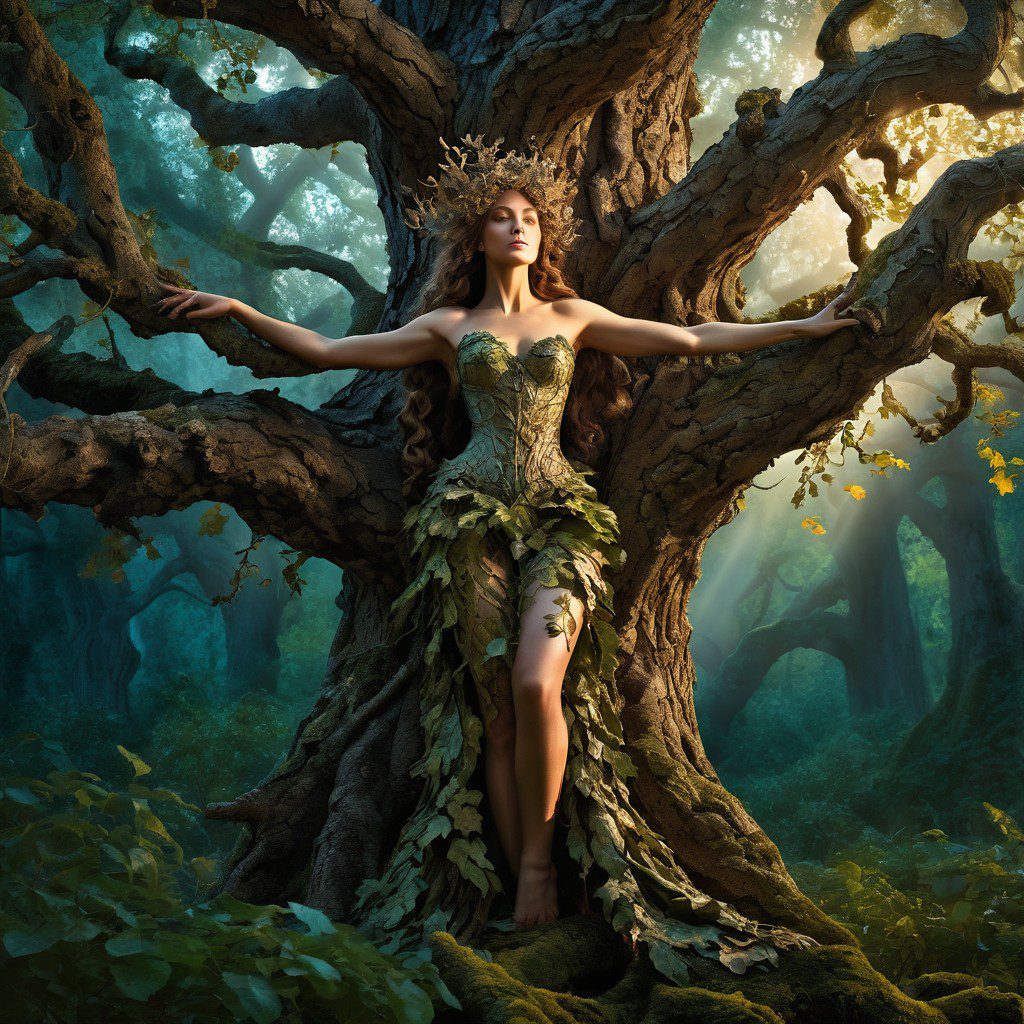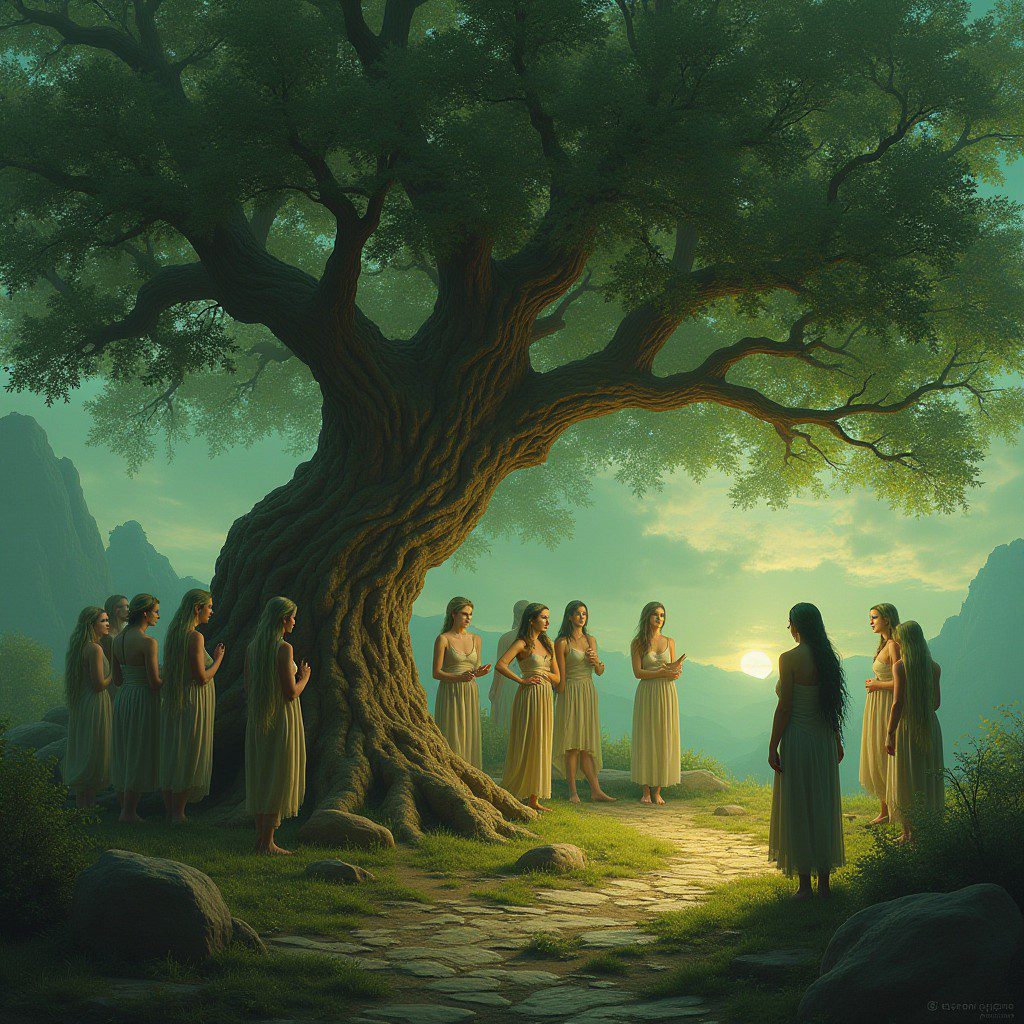Dryads: The Tree Spirits of Greek Mythology and Fantasy

Dryads are tree spirits from ancient Greek mythology, often portrayed as beautiful, feminine beings who embody and protect the trees they inhabit. Associated primarily with oak trees, Dryads are considered nymphs, a type of minor nature deity in Greek mythology. They are deeply connected to the forests, nature, and the life cycles of trees, living in harmony with the wilderness. While typically depicted as gentle and nurturing spirits, Dryads can also be fiercely protective of their homes and the natural world.
Dryads have long been symbolic of the human connection to nature, and they embody the beauty, mystery, and power of the natural world. In modern fantasy, they continue to represent the deep bond between humanity and the environment, appearing in literature, films, and video games as protectors of the forest and the spirits of nature.
Origins and Mythological Background
The concept of Dryads originates from Greek mythology, where they are described as nymphs who are bound to specific trees, often oaks. The word “Dryad” itself is derived from the Greek word drys, meaning “oak.” However, while Dryads are most commonly associated with oaks, they can be linked to other tree species as well, with some specific types of tree nymphs having their own names.
1. Nymphs in Greek Mythology

In Greek mythology, nymphs are minor nature deities who represent various elements of the natural world, including forests, rivers, mountains, and more. Dryads are a subgroup of nymphs associated with trees. These nature spirits are often portrayed as beautiful young women who embody the life force of their respective trees. Nymphs, including Dryads, are considered immortal or long-lived, but their fate is often tied to the health of the natural element they represent.
Unlike the gods and goddesses of Mount Olympus, nymphs typically did not wield great power over mortals but were instead caretakers of the natural world, living in secluded groves, forests, or mountains. Despite their generally benign nature, they were not to be disturbed or harmed, as doing so could invoke their wrath.
2. Dryads and Their Trees
The life of a Dryad is intrinsically linked to the tree she inhabits. In many stories, harming or cutting down a Dryad’s tree can cause her pain or even death, emphasizing the sacred bond between the Dryad and her environment. This connection made them revered figures in ancient Greece, where trees, forests, and nature as a whole were respected as divine and vital forces.
Different types of tree nymphs exist in Greek mythology, including:
- Dryads: Associated primarily with oak trees but sometimes with other species.
- Hamadryads: A special type of Dryad whose life force is entirely bound to a single tree. If the tree dies, the Hamadryad dies as well.
- Meliae: Nymphs of ash trees, sometimes associated with the primordial gods.
Dryads were thought to live in secluded woodlands or groves, often far from human civilization. They could interact with mortals, sometimes helping or guiding them, but they were also known to punish those who disrespected or harmed the forest.
Characteristics of Dryads
Dryads are almost always depicted as female, reflecting the nurturing, life-giving qualities of nature. Their appearance and abilities are closely linked to the natural world, and they are often shown with features that connect them to trees, forests, and the earth.
1. Beautiful and Ethereal Appearance


Dryads are typically depicted as ethereal, beautiful maidens, embodying the grace and serenity of the trees they inhabit. In many stories, they are said to have hair the color of leaves, bark-like skin, or eyes that resemble the colors of the forest. Their connection to nature often manifests in their physical appearance, making them both enchanting and otherworldly.
2. Longevity and Immortality
Dryads are long-lived or, in some stories, immortal beings. However, their immortality is tied to the health of their trees. As long as their tree remains unharmed, the Dryad continues to live. If their tree is cut down or dies, the Dryad either withers away or dies alongside it. This bond represents the idea that nature and life are interconnected and that humans must respect and care for the natural world.
3. Forest Guardians
Dryads are portrayed as guardians of the forest, responsible for the protection and preservation of the trees and the natural world around them. They can be nurturing and gentle, but they are also fierce protectors of their homes. In some stories, Dryads can summon other creatures of the forest, control plants, or use nature-based magic to ward off those who threaten their environment.
In many myths, they are wary of humans, especially those who seek to harm the forest, and may curse or attack those who cut down trees or cause destruction. However, they are also known to aid those who treat nature with respect, providing guidance or protection to lost travelers or those who help preserve the wilderness.
Dryads in Modern Fantasy and Popular Culture
In modern fantasy, Dryads continue to represent nature spirits and protectors of the environment. They often appear in literature, films, and video games as symbols of the connection between humanity and nature, and their portrayal frequently emphasizes themes of environmentalism, conservation, and harmony with the natural world.
1. Literature
Dryads are common characters in modern fantasy literature, often portrayed as mystical and enigmatic figures.
- C.S. Lewis’ The Chronicles of Narnia: In The Chronicles of Narnia, Dryads are portrayed as tree spirits who live in the forests of Narnia. They are loyal to Aslan, the great lion, and are part of the natural world that fights against the forces of evil. In Narnia, they are seen as ethereal beings who can shift between human and tree form, embodying the natural magic of the land.
- Rick Riordan’s Percy Jackson series: In the Percy Jackson books, Dryads are part of the magical world that interacts with the human characters. They are portrayed as quirky, playful beings who are deeply tied to the health of their forests and trees.
- J.R.R. Tolkien’s Middle-earth: While Tolkien doesn’t directly use the term “Dryad,” his Entwives in The Lord of the Rings serve a similar role. The Entwives were the female counterparts of the Ents, tree-like beings who tended to forests and gardens, embodying a protective and nurturing role over nature, much like Dryads.
2. Films and Television
Dryads have appeared in various films and television shows, often as secondary characters or symbols of the natural world. They are frequently portrayed as gentle, ethereal beings who maintain the balance of nature.
- Disney’s Fantasia: In the animated film Fantasia, there is a segment that features nature spirits, including Dryad-like figures who dance and interact with the forest. While not explicitly called Dryads, these figures represent the harmony between nature and the supernatural.
3. Video Games
Dryads are common in fantasy video games, where they often serve as nature-based allies, guardians, or characters who guide players through forest environments.
- World of Warcraft: In World of Warcraft, Dryads are part of the Night Elf race’s lore. They are depicted as half-woman, half-deer creatures who serve as protectors of the forests and wield powerful nature-based magic. They are closely allied with the Night Elves and the wild god Cenarius.
- The Witcher: In The Witcher series, Dryads are portrayed as a reclusive race of tree spirits who live in the deep forests. They are depicted as skilled archers and warriors who fiercely protect their forest homes, particularly in the Brokilon Forest. While capable of communication, they are distrustful of humans and guard their land against trespassers.
- Terraria: In Terraria, the Dryad is a non-playable character who sells items related to nature and purification. She is depicted as a guardian of nature who provides the player with tools to cleanse corruption from the land.
Strengths and Weaknesses of Dryads
Strengths:
- Connection to Nature: Dryads are deeply connected to the natural world, giving them control over plants, trees, and animals. This connection allows them to manipulate their surroundings, such as growing plants to create barriers or summoning animals to assist them.
- Longevity and Immortality: Dryads possess a form of immortality as long as their tree remains healthy. They do not age as humans do, and their lives are tied to the natural cycles of the forest.
- Forest Guardians: Dryads are powerful protectors of their environment. They can call upon the forces of nature to defend the forest from invaders or threats. This can include using plant-based magic, commanding animals, or even influencing the weather within their domain.
Weaknesses:
- Tied to Their Tree: Dryads’ lives are bound to the trees they inhabit. If their tree is harmed or destroyed, the Dryad will suffer, potentially leading to her death. This vulnerability makes them reliant on the protection of their home environment.
- Isolation: In many stories, Dryads live in secluded forests far from human civilization, making them isolated from the wider world. This isolation can make them vulnerable to larger-scale threats or destruction caused by human expansion.
- Distrust of Humans: While Dryads are capable of kindness and assistance, they are often wary of humans, especially those who might harm the forest. This wariness can sometimes lead to conflict or misunderstandings, particularly when humans encroach on their territory.
The Legacy of Dryads: Guardians of the Natural World
Dryads remain a beloved and iconic figure in mythology and modern fantasy, symbolizing the harmony between nature and life. Their deep connection to the forest, their beauty, and their role as protectors of the environment continue to inspire stories about the importance of respecting nature.
Whether depicted as ethereal forest maidens or fierce guardians of the wilderness, Dryads serve as a reminder of the delicate balance between humanity and the natural world, encouraging themes of conservation, respect, and environmental stewardship across cultures and media.
